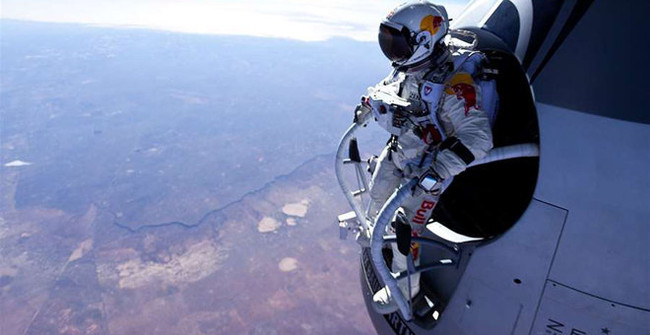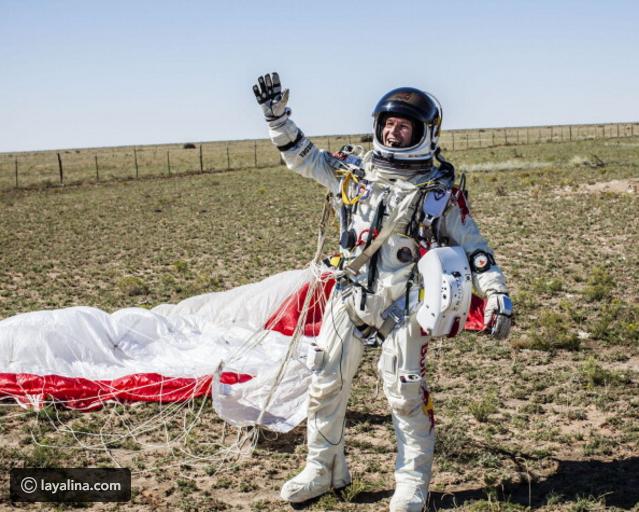Decode the parachute to a speed of 1.357.6 km / h, surpassing the speed of the Austrian athletes
October 14, 2012, Felix Baumgartner of the Austrian paratroopers performed a free-fall performance at 39km altitude after jumping off the balloon with a fall of 1,357.6km / h, faster than speed. sound level 1,235km / h. After 9 minutes, Baumgartner landed safely near Roswell, New Mexico, USA. After this jump, Baumgartner becomes the first to break the speed of sound after 34 seconds of free fall.
The jump from Felix Baumgartner's 39 km high.(Video: YouTube.)
Researchers at the University of Technology in Munich, Germany, have discovered that clothing is the factor that helps Austrian paratroopers break the sound wall. Specifically, when analyzing the hydrodynamic characteristics from Baumgartner's jump, they found that the outfit he wore at the dance had a less smooth shape that reduced aerodynamic resistance, increased the speed of falling. Normally, this resistance increases as the object approaches the sound barrier.
According to the scientists' calculations based on the hydrodynamics of smooth objects, to overcome the sound barrier, which reaches a fast speed of 1,200 km / h or Mach 1, Baumgartner needs to jump from a height of about 37 km . But in fact, Baumgartner has reached a higher speed than Mach 1.25 or 1.357.6 km / h. And the reason is because of rough surfaces like folds on protective clothing and backpacks he wears to hydrodynamics.

Felix Baumgartner is about to make a historic jump.(Photo: Wordpress.)
Professor Ulrich Walter, head of TUM's Department of Astronautics, scientific advisor of the parachute team considered Baumgartner's record as a unique opportunity to study how falling objects have a less smooth shape.
From the data collected on atmospheric pressure, temperature, falling speed and posture of Baumgartner in the air at each time point, researchers can for the first time investigate the aerodynamics of objects Poor smooth shape at extremely high speeds.
In fact, due to many overlapping physical phenomena, it is difficult to calculate hydrodynamics near the sound speed. Specifically, at speeds from Mach 0.7 to Mach 1.3 (864 - 1.605 km / h), the airflow around a moving object reacts in a less flexible way, not elastic. Forming shock waves and turbulence blocks absorbing energy, increasing aerodynamic resistance at speeds close to sound velocity. Under some conditions, a less smooth surface can reduce aerodynamic drag. This is similar to the fact that the golf ball is designed with small indentations on the ball surface to fly faster.

Baumgartner safely landed after a spectacular jump.
To determine the drag coefficient and aerodynamics of arbitrary shaped objects, Walter relied on measured data from the mathematical base he had built earlier to directly calculate the air resistance of the The corresponding object.
The results made the scientists not be surprised. The drag coefficient during Baumgartner's fall was almost unchanged, while the drag coefficient of a smooth cube increased continuously from Mach 0.6 to Mach 1.1 (740 - 1,358 km / h). ). This shows that sound barriers hardly produce additional resistance. The study shows rough types of dimples, wrinkles and surfaces that significantly reduce aerodynamic resistance at subsonic speeds.
See more:
- Why can this man jump from 7,600 meters to the ground without parachutes
- Can ants survive if they fall from the roof of the building?
- Miraculous survival after free fall from a height of more than 5000 meters
You should read it
- 50+ websites download the best free sound effects
- Can ants survive if they fall from the roof of the building?
- Instructions to download Fall Guys for free and get exclusive skins
- Guide to parachuting in PUBG Mobile
- Which smartwatches and fitness trackers have fall detection?
- Tips to survive when parachuting down to 'gold' locations in Rules of Survival
 Why is the airplane wing not so high in flying tape?
Why is the airplane wing not so high in flying tape? Found the 17th leg drifting on the coast of Columbia, there has been a solution to mystery over the past decade
Found the 17th leg drifting on the coast of Columbia, there has been a solution to mystery over the past decade Why is the passenger door up and down on the left side of the plane?
Why is the passenger door up and down on the left side of the plane? A robot ship built inspired by ancient plesiosaurus
A robot ship built inspired by ancient plesiosaurus Partial vision can be restored through new gene therapy
Partial vision can be restored through new gene therapy The most impressive, 'crazy' scientific discoveries in 2017
The most impressive, 'crazy' scientific discoveries in 2017